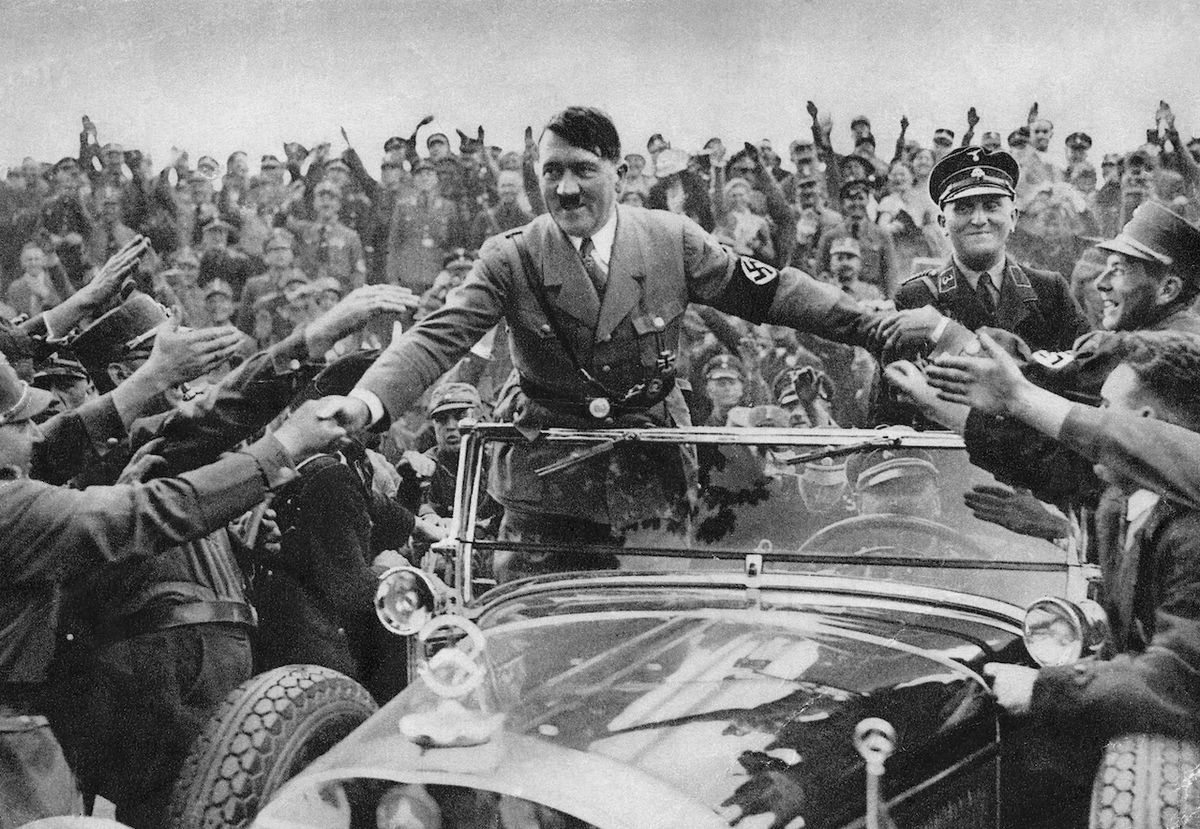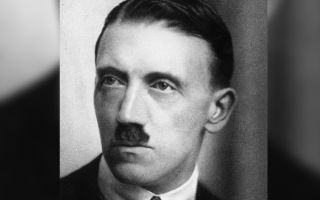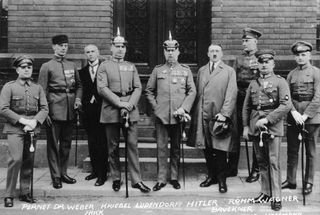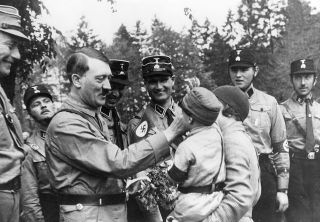How Adolf Hitler rose to power
How did Hitler evolve from a homeless artist to a murderous tyrant?

Adolf Hitler was the unremarkable artist who rose to become the dictator of Germany and the instigator of the Holocaust. Given the devastation left in Hitler's wake, a major question for historians of the 20th century has been how Hitler captured the German imagination and came to power.
He was not, as a person, a charismatic character; biographer Ian Kershaw described him as an "empty vessel outside his political life." He had few genuine friends, an overinflated view of his own intellect and no inborn connections to propel him to the top.
Nor did Hitler have especially original ideas; the German Workers' Party he joined in 1919, which would become the Nazi Party under his leadership, was just one of approximately 70 right-wing groups in Germany after World War I, Kershaw wrote in the biography "Hitler: 1889-1936 Hubris" (W.W. Norton & Company, 1998).
But in the chaos of post-World War I Germany, it was Hitler's group that would gain dominance — and that was not a matter of luck, said Karl Schleunes, author of "The Twisted Road to Auschwitz: Nazi Policy Toward German Jews, 1933-39" (University of Illinois Press, 1970).
"What makes the German Workers' Party different from the other 69 groups is that they don't have a Hitler, whose speaker talent and tactics are really quite effective," Schleunes said.
And once he achieved fame, Hitler was able to cover up his rather off-putting personality with media images of a cultured gentleman beloved by children and animals.
The early years

Hitler's early life does not hint at his future. The son of a low-level civil servant in Austria, Hitler was groomed by his harsh, authoritarian father to become a bureaucrat as well. Other than the beatings from his father, the future dictator's early childhood was relatively normal, but he became sullen and friendless in adolescence, according to Kershaw's biography. He never finished high school and, from 1905 to 1907, sponged off of his mother.
In 1907, Hitler famously failed to win admission to art school, kicking off a period in which he lived in Vienna, making grand pronouncements about art, architecture and culture, but rarely making any serious effort to secure a future in art himself. In 1909, he ended up living for a time in a flophouse for the homeless. He soon turned to supporting himself by selling cheap paintings of city scenes.
In 1913, Hitler went to Munich, fleeing Austrian authorities who'd noticed that he'd dodged mandatory military service there. It was in the German military, however, that Hitler would find direction — and a springboard into politics.
Service in World War I gave Hitler a place in the world for the first time, Kershaw wrote, even as many of his fellow soldiers viewed him as a bit of a socially awkward oddball and prude. Germany admitted defeat in the war as Hitler rested in a hospital, recovering from a mustard gas attack. He returned to his regiment in Munich, Schleunes said, where he ultimately got a job with the information unit, working in military intelligence.
It was this job that put him on a collision course with the German Workers' Party. Hitler had long held right-wing nationalist views, but in a "critical development," Schleunes said, the army sent him to attend university lectures on German history, socialism and bolshevism — from a right-wing perspective.
In particular, Hitler ate up the words of a right-wing economist, Gottfried Feder, and a right-wing historian, Karl Alexander von Müller. It was Müller who noticed that Hitler had a talent for rhetoric, and his recommendations helped Hitler land a job in the intelligence unit as a spy keeping tabs on the German Workers' Party, Schleunes said.
Gaining power
It was Hitler's power as a speaker that turned him from informer to party member, Schleunes said. During a German Workers' Party lecture, someone suggested that it might be best for Bavaria to break from the rest of Germany, splintering the country. Hitler, a German nationalist, was appalled and argued against the idea. The leader of the party, impressed with his speaking style, asked him to join the party. A few days later, on Sept. 12, 1919, Hitler became the 55th member of the party, with the full permission of the army.
Hitler became a fiery speaker on the beer-hall circuit and was willing to risk the humiliation of low turnout by organizing rallies in large spaces, Kershaw wrote. His organizing talents propelled him to the top of the party's leadership.
In 1920, Hitler and the other leaders of the party changed its name from the German Workers' Party to the National Socialist German Workers' Party (Nationalsozialistische Deutsche Arbeiterpartei, or "Nazi" for short). In 1921, Hitler was voted chairman of the party and took total control. The once-tiny group began to draw new members, absorbing other right-wing groups, Schleunes said.
Hitler remained a cold presence in person. "He's not an interesting conversationalist," Schleunes said. "He's really sort of a dull person, except when he appears before an audience, when somehow, a switch is turned on. He could milk an audience and shape it and get it to feel."
If Hitler's speaking abilities gave him the roots to flourish in the early Nazi Party, the chaos and resentment of Germany at the time were the soil that made his growth possible.The German people were in shock after losing World War I, Schleunes said. They'd been told throughout the war that they were winning. They faced food and coal shortages, and ended the war with millions killed and wounded. But these sacrifices were necessary, according to the army, because victory was close.
"They're told that for four years, and suddenly, they're told that 'We lost the war,'" Schleunes said. To understand how such a thing could happen, many turned to conspiracy theories — particularly, the theory that Jewish people on the home front had stabbed Germany in the back. "The situation, for someone like Hitler, is ripe," Schleunes said.
A wider popularity

Violence marked Hitler's early rise. By 1923, he was emboldened enough to attempt to overthrow the government of Bavaria by force, which he hoped would eventually lead to the overthrow of the national government in Berlin.
This "Beer Hall Putsch" failed, but there was widespread sympathy for Hitler's aims, Schleunes said. His trial became a megaphone broadcasting his ideas, and his light 9-month stint in prison gave him the opportunity to dictate the "almost unreadable" but wildly popular biography "Mein Kampf," Schleunes said.
"Hitler was smart enough to realize after the failure of his “Beer Hall Putsch” that he and his party could not come to power with violence against the institutions of the state, especially the army and the police," said Dr Benjamin Hett, author of "The Death of Democracy: Hitler’s Rise to Power and the Downfall of the Weimar Republic" (Henry Holt and Co, 2018). "They could only come to power by getting inside the system, and the path to that was through winning elections".
There were many factors that led to Hitler's more widespread acceptance in Germany, from economic depression to the country's hatred of the Treaty of Versailles that ended World War I. But Hitler managed to expand his appeal from the beer-soaked halls of Munich to the rest of the country, in part via the mass media.
In 1932, he ran for president and struggled to reach middle-class voters, said Despina Stratigakos, a historian of architecture and the author of "Hitler at Home" (Yale University Press, 2015). To rehabilitate his personal image, he focused on his domestic portrayal. Instead of downplaying his transient, rather lonely personal history, Hitler and his propaganda team started to foreground his personal life.

"He's being presented as a good man, a moral man, and the evidence for that comes from his private life," Stratigakos told Live Science. "It's fabricated, but it's very effective."
Hitler lost the 1932 election, but gained the support of many influential industrial interests. When the parliamentary elections failed to establish a majority government, Germany's president Paul von Hindenburg caved to outside pressure and named Hitler chancellor (the role of chancellor in Germany is similar to that of Prime Minister in other parliamentary systems, and Germany had both a president elected by the people and a chancellor representing the majority party in the government).
In 1933, the Reichstag building was set on fire, which Hitler used as a pretext to seize emergency powers and detain his political enemies. With communists and other leftists under arrest, he was able to push a law called the Enabling Act through parliament. The Enabling Act allowed Hitler's cabinet to institute legislation without parliamentary consent.
With the backing of the conservative German National People's Party (DNVP) and with the left-leaning Social Democratic Party of Germany (SPD) barred from attending the vote on 24 March 1933, Hitler’s proposal was passed by 444 votes to 94, a key step in usurping the democratic institutions of the state.
“In the wake of this law came what the Nazis called ‘Gleichschaltung’, or coordination, a process in which any organization at all that could possibly form the basis of opposition was abolished or taken over by the Nazis,” said Hett. “This process was largely completed by July of 1933, when all political parties except the Nazis were formally outlawed.”
As Hitler strong-armed his way to dictatorship, profiles of him rusticating in his residence in Obersalzberg, Bavaria, portrayed him as a cultured gentleman, beloved by dogs and children. Working with the architect Gerdy Troost, Hitler created a space with an expansive Great Hall that seemed inspired by the artist salons of pre-World War I Munich, Stratigakos said. German and English language magazines printed fluffy pieces on the Führer at home.
"Even the American Dog Kennel Gazette had this feature on Hitler as a dog lover," Stratigakos said. These cozy, domestic scenes helped soften the image of the Hitler. The strategy was so successful that the most-sold images of 1934 were pictures of Hitler at home playing with his dogs or with children.
Through his organization, oratory and public relations, Hitler "the nonentity, the mediocrity, the failure," as Kershaw called him, had become not only the chancellor of Germany, but a beloved celebrity. The transformation was complete.
Additional resources
To read more about the life and rise of Hitler, you can visit The National WWII Museum website. Additionally, you can watch this TED Talk video by Alex Gendler and Anthony Hazard.
Bibliography
- "Hitler: 1889-1936 Hubris" (W.W. Norton & Company, 1998)
- "The Twisted Road to Auschwitz: Nazi Policy Toward German Jews, 1933-39" (University of Illinois Press, 1970).
- "The Death of Democracy: Hitler’s Rise to Power and the Downfall of the Weimar Republic" (Henry Holt and Co, 2018).
- "Hitler at Home" (Yale University Press, 2015)
Sign up for the Live Science daily newsletter now
Get the world’s most fascinating discoveries delivered straight to your inbox.

Stephanie Pappas is a contributing writer for Live Science, covering topics ranging from geoscience to archaeology to the human brain and behavior. She was previously a senior writer for Live Science but is now a freelancer based in Denver, Colorado, and regularly contributes to Scientific American and The Monitor, the monthly magazine of the American Psychological Association. Stephanie received a bachelor's degree in psychology from the University of South Carolina and a graduate certificate in science communication from the University of California, Santa Cruz.
- Jonathan GordonEditor, All About History












